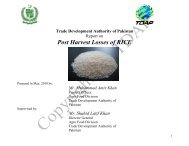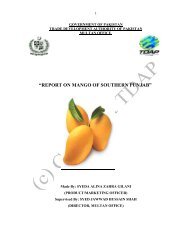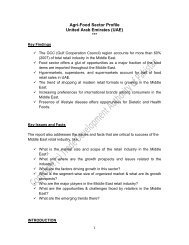TALC (SOAP STONE) - Trade Development Authority Of Pakistan
TALC (SOAP STONE) - Trade Development Authority Of Pakistan
TALC (SOAP STONE) - Trade Development Authority Of Pakistan
You also want an ePaper? Increase the reach of your titles
YUMPU automatically turns print PDFs into web optimized ePapers that Google loves.
<strong>Trade</strong> <strong>Development</strong> <strong>Authority</strong> of <strong>Pakistan</strong><br />
Minerals & Minerals Division<br />
Formation of Talc<br />
Page 4<br />
Report on Talc<br />
Talc is a metamorphic mineral (1) resulting from the metamorphism of magnesium minerals such<br />
as Serpentine, Pyroxene, Amphibole, Olivine, in the presence of Carbon Dioxide and Water.<br />
This is known as Talc Carbonation or Steatization and produces a suite of rocks known as<br />
Talc Carbonates.<br />
Talc is a mineral of Hydrous Silicate of Magnesium with Chemical Formula of Mg3Si4O10(OH)2 .<br />
1. Talc is primarily formed via hydration and carbonation of serpentine, via the following<br />
reaction:<br />
serpentine + carbon dioxide → talc + magnesite + water<br />
2Mg3Si2O5(OH)4 + 3CO2 → Mg3Si4O10(OH)2 + 3 MgCO3 + 3 H2O<br />
2. Most talc is formed from the alteration of Dolomite (CaMg(CO3)2 or of Magnesite<br />
(MgO) in the presence of excess dissolved Silica (SiO2). Talc can be formed via a<br />
reaction between Dolomite and Silica, which is typical of skarnification of Dolomites via<br />
silica-flooding in contact metamorphic aureoles:<br />
dolomite + silica + water → talc + calcite + carbon dioxide<br />
3CaMg(CO3)2 + 4 SiO2 + H2O → Mg3Si4O10(OH)2 + 3 CaCO3 + 3 CO2<br />
3. Serpentine or Quartzite can also form talc. Talc can be formed from magnesian chlorite<br />
and quartz in blueschist and eclogite metamorphism via the following metamorphic<br />
reaction:<br />
chlorite + quartz → kyanite + talc + water<br />
Associated Minerals:<br />
Dolomite, Magnesite, Quartz, Olivine, Pyroxenes, Serpentine, Amphiboles and Biotite<br />
(1) Metamorphic Mineral is the result of the transformation of a pre-existing rock type. They are formed by the intrusion of<br />
molten rock, called magma, into solid rock where the temperatures are high.









